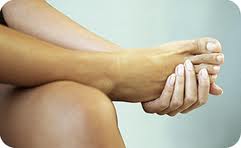 Everyday our feet are affected by wear and tear. But did you know that by the age of 40, you can lose up to 50% of the fat pads in your feet?
Everyday our feet are affected by wear and tear. But did you know that by the age of 40, you can lose up to 50% of the fat pads in your feet?
Maybe you’re thinking, “So what? It’s fat. I don’t want fat feet.” Well, you do want these fat pads. The metatarsal fat pads in the balls of your feet are pockets in the plantar fascia that are filled with fatty tissue. You also have 1-inch fat pads covering your heel bones. These fat pads act as shock absorbers, cushioning your foot bones, joints and soft tissues.
When these fat pads thin or decrease in size, your bones have to bear the force and weight of each step you take since there’s less shock absorption. Eventually, pressure areas develop in the metatarsal and/or heel areas, producing inflammation and pain. And, unfortunately, once you’ve lost those fat pads, they’re gone for good.
What Causes the Fat Pads to Thin?
The most common causes of fat pad atrophy include:
Age – Your fat pads diminish with age, depending upon genetics. This condition is common in seniors.
Systemic Disorders – Medical conditions like diabetes and rheumatoid arthritis can affect the soft tissues and/or bones in your feet.
Certain Sports or Activities – These sports or activities, such as running, can cause increased stress upon your feet.
Certain Types of Shoe Usage – Frequent wearing of thin- sole or high-heel shoes can cause excessive, prolonged pressure on the balls of your feet.
Fat Pad Displacement – In some situations, the fat pad can shift or move toward the toes, which means it’s no longer in an optimal position to protect the metatarsal bones.
Misaligned Metatarsal Head – In situations where a metatarsal head falls out of alignment, the fatty pad between it and the skin will wear away due to increased pressure.
What Are some Symptoms of this Condition?
- Pain in the ball of the foot or in the heel.

- Pain that causes a deep, dull ache.
- Significant pain when standing and/or walking.
- Your toes may feel numb or tingle.
- Calluses may form on your heel or the ball of the foot.
How Do You Treat Fat Pad Atrophy?
- Wear shoes with extra padding at all times.
- Don’t walk barefoot on hard surfaces like ceramic tile, hardwood, or concrete, which can aggravate the pain.
- Wear custom orthotics like the ezWalker® Performance Insole. Biomechanically designed to enhance your gait, these insoles minimize the stress on your metatarsal and heel bones by supporting your arches and reducing the pressure on the balls of your feet and your heels. The ezWalker® Insole is customized to the contours of your feet using our unique 7-step casting process – providing a custom fit with custom-made comfort.
ezWalker® Performance Insoles can be purchased via the Internet, so anyone, from anywhere, can own a pair. We also offer one-on-one fittings at no extra charge for local customers and free consultations via phone or Skype for non-local customers. Contact us to schedule an appointment.
The ezWalker® insole comes with a 90-day, money-back guarantee. So, what do you have to lose – except your pain? Try it today!
Put an ezWalker® in your shoes and put a smile on your face. Remember … when your feet feel good, you feel good.
Note: If you follow these guidelines and your pain persists, you may have a more serious condition. See your doctor for a more complete diagnosis and treatment.

